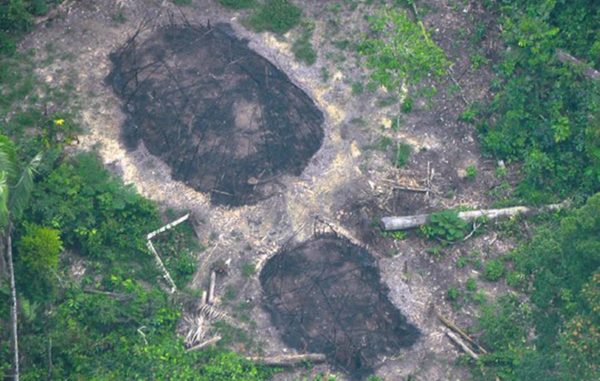
by Deep Green Resistance News Service | Sep 9, 2017 | Colonialism & Conquest
Featured image: Evidence of an attack? Burnt communal houses of uncontacted Indians, seen in December 2016, could be signs of another massacre in the Uncontacted Frontier. © FUNAI
by Survival International
Public prosecutors in Brazil have opened an investigation after reports that illegal gold miners in a remote Amazon river have massacred “more than ten” members of an uncontacted tribe. If confirmed, this means up to a fifth of the entire tribe have been wiped out.
Two miners have been arrested.
The killings allegedly took place last month along the River Jandiatuba in western Brazil, but the news only emerged after the miners started boasting about the killings, and showing off “trophies” in the nearest town.
Agents from Brazil’s indigenous affairs agency, FUNAI, confirmed details of the attack to Survival International. Women and children are believed to be among the dead. FUNAI and the public prosecutor’s office are currently investigating.
The area is known as the Uncontacted Frontier, as it contains more uncontacted tribes than anywhere else on Earth.
Several government teams who had been protecting uncontacted indigenous territories have recently had their funding slashed by the Brazilian government, and have had to close down.
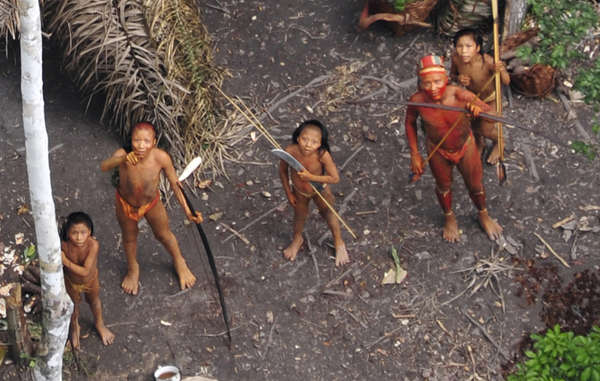
Uncontacted Indians in the Brazilian Amazon, filmed from the air in 2010. © G.Miranda/FUNAI/Survival
President Temer’s government is fiercely anti-Indian, and has close ties to the country’s powerful and anti-indigenous agribusiness lobby.
The territories of two other vulnerable uncontacted tribes – the Kawahiva and Piripkura – have also reportedly been invaded. Both are surrounded by hundreds of ranchers and land invaders.
Uncontacted tribes are the most vulnerable peoples on the planet. However, when their rights are respected, they continue to thrive.
All uncontacted tribal peoples face catastrophe unless their land is protected. Survival International is doing everything it can to secure their land for them, and to give them the chance to determine their own futures.
Survival’s Director Stephen Corry said: “If these reports are confirmed, President Temer and his government bear a heavy responsibility for this genocidal attack. The slashing of FUNAI’s funds has left dozens of uncontacted tribes defenseless against thousands of invaders – miners, ranchers and loggers – who are desperate to steal and ransack their lands. All these tribes should have had their lands properly recognized and protected years ago – the government’s open support for those who want to open up indigenous territories is utterly shameful, and is setting indigenous rights in Brazil back decades.”
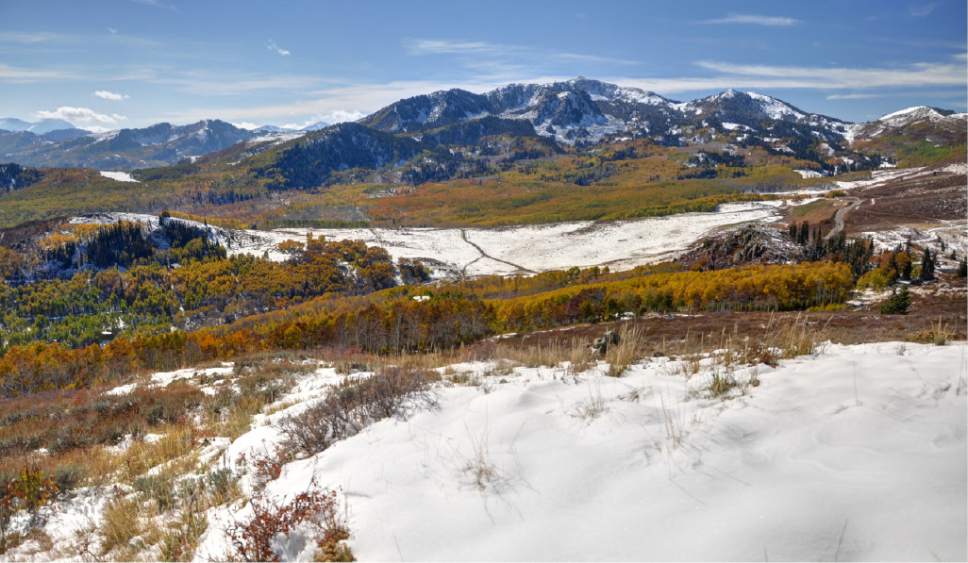
by Deep Green Resistance News Service | Sep 8, 2017 | Human Supremacy
Featured image: Bonanza Flats
Editor’s note: This is the second installment in a multi-part series. Browse the New Park City Witness index to read more.
by Will Falk / Deep Green Resistance
Before murdering millions during the Holocaust, the Nazis referred to Jews as rats. After murdering 17 people and lobotomizing some of his victims in an attempt to preserve them, alive but in a catatonic state, serial killer Jeffrey Dahmer explained, “…I tried to create living zombies…I just wanted to have the person under my complete control, not having to consider their wishes, being able to keep them there as long as I wanted.” In vivisection labs, scientists commonly cut animals’ vocal cords, so the scientists don’t have to listen to the animals scream.
These examples illustrate a common psychological phenomenon: In order to commit atrocities, humans characterize their victims as sub-human, objectify and silence them. It is, after all, much easier to destroy the less than human and the voiceless.
Civilized humans are currently destroying the natural world. Water continues to be polluted, air is poisoned, soil is lost faster than it can be replaced, and the collapse of every major biosphere across the planet intensifies. This destruction is made possible through the objectification and silencing of the natural world. The American legal system defines nature as property. Capitalism calls nonhumans “natural resources” and only values them as profits. The Abrahamic religions remove the sacred from the natural world and give it to an abstract, patriarchal God who somehow exists beyond the natural world.
It’s no wonder, then, that many in Park City participate in the silencing of nature, too. Many Parkites, for example, celebrate the existence of thousands of acres of land designated as “protected open space.”
There are several problems with this. First, the term “open space” is dishonest and works to objectify nonhumans while silencing the natural world. Objectification and silencing pave the way for exploitation. Second, as long as runaway climate change threatens snowfall, creates droughts, and contributes to wildfire intensity, no natural community in Park City can truly be considered “protected.” To call endangered natural communities protected leads to complacency, and we cannot afford complacency while the world burns.
The “Save Bonanza Flats” Campaign, which raised $38 million to protect 1,350 acres of high-altitude land from development, was a beautiful expression of the community’s love for life. Do not mistake me, I am deeply glad that Bonanza Flats is safe from hotels and multi-million dollar homes. But, Bonanza Flats is not safe, and will never be safe, as long as the dominant culture’s insatiable appetite for destruction is ensured by humans who believe the natural world is nothing more than lifeless matter for humans to use.
***
While working on this essay, I decided to head up Guardsman Pass to ask those who live in Bonanza Flats what they think about “protected open space.” Hiking is contemplative for me. I was asking myself just how, exactly, I thought the nonhumans in Bonanza Flats would express their feelings about being “open space” when I rounded a bend to find myself face to face with a bull and cow moose grazing among the aspen.
The aspen were mature, many of them boasting trunks eighteen and twenty-four inches in diameter. They grew closely together, creating an ancient silvan atmosphere with dappling silvers, golds, and greens. The afternoon sunshine mixed with aspen leaves to give me the slight, pleasant sense of existential vertigo that accompanies the timelessness of life’s original joys.
I met the bull moose’s gaze. My bones recognized their nearness to a greater collection of their kindred. My muscles, observing the moose’s, remembered their first purpose and tingled with excitement. His eyes, browns in brown, reflected all the different woods he’d ever strode through. I’m not sure how long we considered each other, but when he finally looked away, his wisdom was undeniable.
And, I had my first answer: To share an aspen grove with a bull moose in Bonanza Flats, is to know this space is anything but open.

I continued on to find a stone to sit on and watched the lazy orange flutter of butterfly wings. I listened to the soft hum of bees, the breeze through quaking aspen leaves, and the hypnotic click of grasshoppers in flight. I saw mule deer bounding over a fence, a red-tailed hawk riding wind pockets, and squirrels tossing pine cones to the ground, narrowly missing human heads (for the squirrels’ winter caches). All these beings confirmed the lesson the bull moose taught me. Bonanza Flats is not open, it is filled with countless living beings.
An approaching rain cloud brought tidings of the radical interconnectedness of all life and proved that Bonanza Flats is not truly protected. When the cloud arrived to give its water, the rain evaporated well before it reached us. I was reminded that Bonanza Flats, like all communities along the Wasatch Range, depend on snowpack for life-giving water. Simple arithmetic tells us that as long as total snowpack diminishes decade after decade, as it has been since the 1950s, sooner or later there won’t be enough water left.
While Bonanza Flats is safe from the developers’ bulldozers and chainsaws, many threats, just as deadly, still exist. Marssonina fungus spores, aided by climate change, could spread over aspen leaves until they no longer quake. Shorter winters allow the tiny pricks of too many tick bites to suck moose lives away. The worrisome scent of wildfire smoke haunts the wind. And, the asthmatic cough of children brought to the mountains by their parents to escape the Salt Lake Valley’s terrible air quality ring across Bonanza Flats’ trails.
***
Not all humans have objectified and silenced the natural world. For the vast majority of human history, humans lived in balance with the natural world we depend on. We lived in this way, in part, because we developed cultures that taught the sacredness of the natural world.
I’m writing this from the eastern edge of the Great Basin where the Western Shoshone, Paiute, Goshute, Washo and others lived sustainably for millennia. Much of my work in the region has been to protect pinyon-juniper forests from government-sponsored clearcuts. The forests make poor livestock grazing and ranchers make more money when the forests are replaced with grasses, so the forests are demonized. And, just like the demonization of Jews led to the Holocaust, the demonization of pinyon-juniper forests leads to millions of acres of clear-cuts.
Food from pinyon pine nuts and medicine from juniper trees were staples in many of the Great Basin’s traditional cultures. Pine nuts and juniper berries can be harvested without damaging the forests, so native peoples lived on what the land freely gave. In my research, I stumbled upon the transcript of a presentation[1] Glenn E. Wasson, a Western Shoshone man, gave at a pinyon-juniper conference hosted by the University of Nevada-Reno, the United States Forest Service, and the Bureau of Land Management. His words describe his people’s spirituality and represent a healthy relationship with the natural world.
Wasson said, “Each living entity constitutes a link in the chain of life. All those seen and unseen, all who grow from the ground, all those who crawl, all those who swim, all those who walk on legs, all those who fly, are all intertwined in the chain of life. Each plays a vital role in the keeping of a strong, healthy, and living Mother Earth, who provides each and every entity with all the necessities for life.” Contrast Wasson’s worldview with the dominant culture’s conception of nature as property, as resources, as objects and we begin to see why we’re in the mess we’re in.
While criticizing the Forest Service and BLM’s treatment of pinyon-juniper forests, Wasson described the mindset all of us must embrace. He said “…the cutting down of a single living tree is sacrilegious – the cutting down of a forest – UNTHINKABLE!” Until we begin to see individual nonhumans as sacred and natural communities worthy of our utmost respect, the destruction will continue.
Simply changing our language will not stop the destruction and I am not criticizing anyone’s efforts to protect Bonanza Flats from development. We need much more than better words and any land that stands free of development today, has a chance to stand free of development tomorrow. Land developed today may take decades to recover.
It’s not just Bonanza Flats. Park City boasts 8,000 acres of so-called protected open space. These are not protected open spaces. These are living natural communities where countless nonhumans live with lives as valuable to them as yours is to you. And, their lives are under attack.
I’m not writing anything you don’t already know. Most people in Park City are concerned about the natural world. Unfortunately, it appears that most Parkites are more interested in using the natural world, than in saving it. Why do I say this? Well, ask yourself, do most people in Park City spend more time confronting the forces destroying snow, or more time skiing on it? Do most people spend more time working to protect threatened Canada lynx, or more time mountain biking through Canada lynx’ homes? Do most people spend more time trying to save Colorado Pikeminnows, or more time flying fishing the waters Colorado Pikeminnows swim through?
There’s nothing wrong with enjoying the natural world. But, nonhumans do not exist for human enjoyment, they exist for themselves. It is only through centuries of cultural conditioning, teaching us to see the natural world as full of objects for our use, that some humans find nothing wrong with spending more time riding bikes than fighting for our nonhuman kin.
Life is created by complex collections of relationships formed by living creatures in natural communities. Water, air, soil, climate, and the food we eat depend on natural communities. The needs of these communities are primary; morality, the efforts of our daily lives, and our cultural teachings must emerge from a humble relationship with these natural communities. True sustainability is impossible without this.
Not long ago, all humans lived in humble relationships with natural communities. We developed traditional cultures that were rooted in the connectedness of all living beings. These cultures insisted upon the inherent worth of the natural communities who gave us life. Members of these cultures did not know “open spaces,” they knew places filled with those who grow from the ground, those who crawl, those who swim, those who walk on legs, and those who fly.
The dominance of a culture that objectifies and silences nature and calls natural communities “open space” enables its destruction. This culture has pushed the planet to the verge of total collapse. To avert collapse, the destruction must stop. We must create cultures where the exploitation of individual nonhumans is sacrilegious, and wholesale environmental destruction is unthinkable. We must stand in solidarity with all those – human and nonhuman – who share this living community we call Park City.
[1]Wassen, G.E. 1987. The American Indian response to the pinyon-juniper conference. In: Everett, R.L., comp. Proceedings: Pinyon-juniper conference. Gen. Tech. Rep. INT-GTR-215. Ogden, UT: U.S. Department of Agriculture, Forest Service, Intermountain Research Station: 38-41.
To repost this or other DGR original writings, please contact newsservice@deepgreenresistance.org
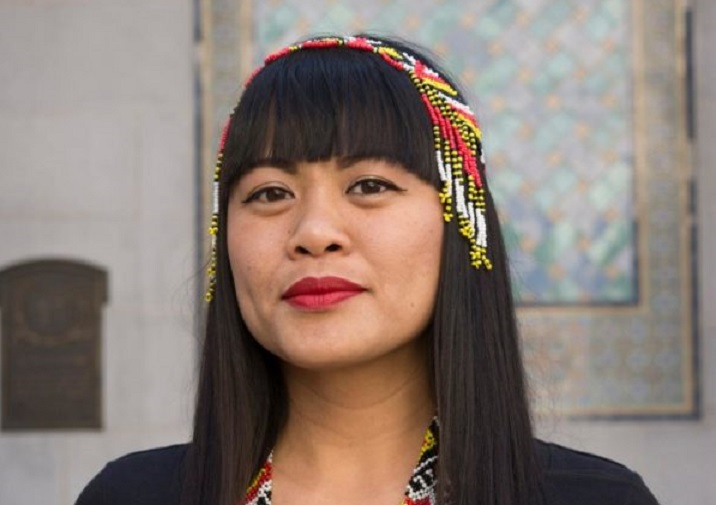
by Deep Green Resistance News Service | Sep 5, 2017 | Male Supremacy
Featured image: Jollene Levid (Photo: AF3IRM LA Coordinator Roxanna Avila). National chairperson of AF3IRM, Jollene Levid, speaks with Meghan Murphy about rise of white nationalism in the US, how the alt-right is connected to male supremacy, and what movements can do to better address violence against women of colour.
by Meghan Murphy / Feminist Current
While the rise in white nationalist activity in the U.S. (and the recent death of a woman named Heather Heyer, who was killed when a car plowed into a crowd of people protesting a white supremacist rally) has sparked discussions, anger, and protests against the alt-right and the white supremacist movement, what has been discussed less is the role of male supremacy. Male violence against women of colour is too-often ignored both in the media and by leftist groups. In order to discuss the connections between misogyny and racism, and what the feminist movement and other progressive movements can do to better address those connections and that violence, I spoke with activist and feminist Jollene Levid.
Jollene Levid is a second generation Filipina-American union organizer and social worker from Los Angeles. For the past 15 years, she has been involved in AF3IRM, an anti-imperialist, transnational feminist organization with 10 chapters across the US. AF3IRM fights for im/migrant women’s rights, and against trafficking and militarism. Jollene is the Founding Chairperson, and currently serves on AF3IRM’s International Committee.
~~~
Meghan Murphy: While the fact of racism as a direct motivation for what happened recently in Charlottesville is a clear, what’s been discussed less, in terms of the rise of the alt-right and (public) white nationalist activity, is male supremacy. Do you see patriarchy and misogyny as connected to the incident in Charlottesville and the rise of the alt-right more broadly?
Jollene Levid: It is no coincidence that the faces of the Charlottesville white terrorists are men. I think that this is an important thing to pause and think about. I think it’s also important to think about the fact that in the few centuries that the US has existed as a country, white supremacy’s spokespeople have always been white men… Bedsheet or no bedsheet.
What we learned in AF3IRM through the study of the history of patriarchy itself is that the first place that a man learns about subjugation of women is in the home. It is programmed, it is structural, and it is no surprise that the alt-right espouse male supremacy just as vehemently as white supremacy.
M: Websites and online forums like 4chan, 8chan, and Reddit have provided a way for Men’s Rights Activists (MRAs) to congregate and increase their presence in public discourse, as well as to recruit and build their numbers — do you see this bolstering of MRA activity and discourse as connected to the white nationalist movement?
J: Yes. This is an important moment we are living in. When we take a step back and think about US history and stages in which there is a sharp economic turn – Reconstruction Era, the Great Depression, the 1970s — we see the same trends amongst white men who see themselves as “attacked” or “disenfranchised.” That trend is to increase xenophobia, racism, sexism. Who is allowed to work the “desirable jobs”? Who is allowed to enter the country? Who is allowed basic rights like voting and fair housing?
When you look at MRA public discourse and white supremacy, the intersections are apparent and the grievances are the same. We live in an imperialist era and these white men are feeling “victimized” — so they in turn increase violence against those with less power than them.
MRAs and white supremacists are of the same crop.
M: While people of colour are subjected to various forms of violence in North America, via the state, the police, the prison system, on the street, in their homes, etc., the issue of race as a factor specifically in terms of male violence against women is also a reality. Do you feel this issue is discussed or addressed effectively in public discourse or in the media? Do you feel women are left out of the conversation about racist violence in the US, specifically?
J: Race and violence against women are absolutely not discussed enough in the media or in our communities of colour, even in our movements.
I want to provide some concrete examples. When Trayvon Martin was brutally murdered by George Zimmerman in Florida in 2012, there was an all-out call to take the streets for Trayvon and all black people murdered by the state and those not held accountable by it.
AF3IRM in its eight chapters at the time attended protests nationally, attended meetings, answered the call, chanted, screamed, and wept.
We proudly followed the leadership of the queer black women who founded Black Lives Matter — Alicia Garza and Patrisse Cullors. Many of us who are mothers of black and brown children found an additional home in the movement.
After Sandra Bland was killed and there was a call for #SayHerName protests, we showed up with the same voracity, even joining planning and leadership groups in our respective cities like the Bay and New York City.
When we got to the mobilizations across the countries, what did we see? Emptiness. Maybe a hundred protesters at each mobilization, maybe not. There was a moment on a national AF3IRM call when we had to ask one another how the mobilizations looked and a slow realization that they were smaller than any of the other protests.
We immediately turned inwards and looked at our work — did we not organize effectively or work hard enough? Was the messaging and media around deaths like that of Aiyana Jones not covered or projected enough?
We came to the conclusion that, no, the problem was not with failures in organizing or ineffective messaging. This is a result of all the people who did not have as strong a lens on gender violence, gender oppression, and patriarchy, deciding it was not as important to protest the killings of black women and girls as that of the men and boys targeted by the police. Instead of double or triple the amounts of people showing up to protest because of double oppressions, we see less. The crowd was predominantly women of colour.
Even more — where were the white American feminists who work day in and day out against violence? Were the lives of black women and girls not as important, were their deaths not enraging enough to show up for?
The experience is reflected in other protests — why is it that AF3IRM is one of the only feminist groups in the US putting forward the crisis of the 1,200+ missing and murdered Indigenous women and girls in North America? What about the fact that, in the Philippines, the fascist President Duterte is allowing — even encouraging troops — to rape women under martial law in Mindanao?
We go back to the feminist question that brought us to women’s organizing to begin with: why are women secondary, even in our social justice circles? Why are women and girls of colour not on the radar of the liberal, white feminist movement?
M: Do you believe the left — and specifically groups like Antifa and Black Lives Matter — are addressing misogyny and male violence against women in their activism? If not, why? What could be done differently?
J: Regarding Antifa and BLM and other groups: In our interface with BLM, which has been positive, we understand that each chapter looks different. I know their platform, their leadership, their written strategic plans include and prioritize women. The #SayHerName protests had BLM leaders in our respective cities. They did not have the mass mobilization of people that the other protests had. I hope that folks that subscribe to BLM’s ideological and political platforms follow the lead of women like Alicia Garza and Patrisse Cullors in their calling for the abolishment of patriarchy along with race and class oppressions.
For Antifa groups who have taken the forefront of defense against Nazis even moreso in recent months, their public stances do not have a strong stance against patriarchy.
I spoke with an AF3IRM woman who navigates these spaces — primarily in the anarcho feminist collectives. In those spaces, which have overlap with Antifa, there was strict accountability for men who engaged in sexual assault, harassment, etc. They were removed immediately. It is the lack of a programmed, public stance that is the problem (unlike BLM).
M: Helen Lewis recently wrote about the “Day Three Story,” explaining that many terrorists’ first victims are their wives (or girlfriends/other female family members). How does terrorism connect to domestic abuse? Do you think feminism has a role to play in addressing the mass shootings and terrorism that have become so commonplace these days?
J: I think it’s important to first talk about who is a “terrorist.” I think when we step back and look at where we are politically, economically, we also have to see the US in its complicity and in its role for creating, training these terrorists.
Feminism has a role in addressing mass violence if it does what it should do: be a comprehensive movement.
Feminists are not responsible for the mass violence happening in the world, but we are responsible for building a movement to address the roots and the product (the mass violence). Feminism is responsible for anti-racist work, for anti-imperialist work, for expanding our work to a global level. This issue in particular exposes our weakness as a movement. Why are feminists — who are thoroughly and publicly and ideologically feminist leaders — not at the forefront and deeply embedded in the anti-war movement, in the immigrant rights movement, in the workers’ rights movement? Why are they separate?
We can’t decry violence and not be part of dismantling the system at the root of it. That includes the multiple oppressions in addition to patriarchy.
M: What role do women play in the alt-right, if any? Do women have any responsibility, in terms of the rise of white nationalism in the US, or do you consider them to be victims of male supremacy (as well as victims of the individual men who spout racism and anti-semitism, and perpetrate acts of violence like the one that took place recently in Charlottesville).
J: Yes they do. White women are also to blame for the rise and consolidation of the alt-right. White women voted for Trump. They are more than complicit — they are comrades in the white supremacist movement. They may experience patriarchy, of course, but that does not excuse them. They become a tool of patriarchy and sexism in their both their active engagement in the white supremacist movement as well as their complicity in it.
To learn more about AF3IRM, visit: www.af3irm.org. Af3irm’s national summit will be held on October 21st in New York City
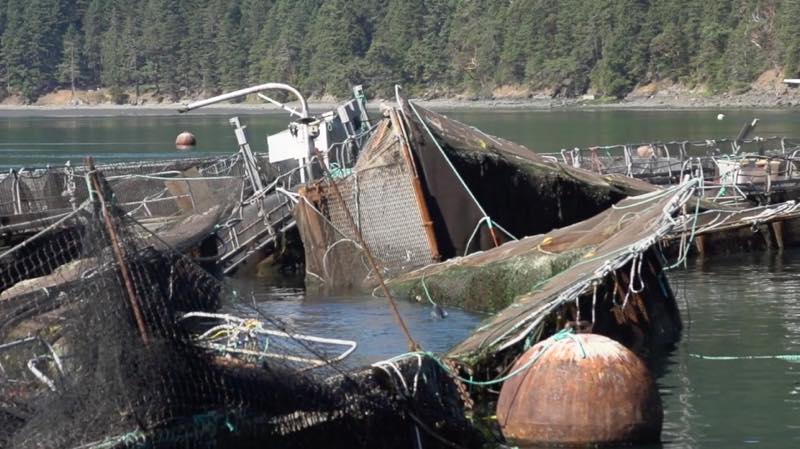
by Deep Green Resistance News Service | Aug 29, 2017 | Agriculture
Featured image: Still from video showing the broken pens of 300,000 Atlantic salmon that escaped from a fish farm off Cypress Island in Washington State. Vimeo/Wild Fish Conservancy
The Lummi Nation, the third largest tribe in Washington State, is in a state of emergency following the structural collapse of the Cooke Aquaculture open net-pen facility near Puget Sound. The breach released more than 300,000 farmed Atlantic salmon into Pacific waters, adjacent to Cypress Island, just east of the Canadian border near Victoria B.C.
State officials announced over the weekend that no new permits would be issued for fish farm operations until the cause of the incident was determined. Lummi Nation Fisheries have been catching thousands of Atlantic salmon alongside wild Pacific salmon for several days, but officials still believe many of the invasive fish are already on their way to spawn in local streams and rivers. Tribal fishermen have hauled in at least 200,000 pounds of invasive Atlantic salmon since the emergency declaration, the Lummi said on Monday August 28.
“This disaster could have devastating effects and could potentially decimate this year’s run of Chinook salmon,” said Lummi Natural Resources Director Merle Jefferson. “This is unacceptable for all residents of the Puget Sound. We are doing what we can to help limit the damage, but as far as we know, containment is indefinite. These invasive fish are going to find our rivers.”
Kurt Beardslee, director of the Wild Fish Conservancy Northwest (WFCN) called the incident an environmental disaster and is preparing to file a civil suit against Cooke Aquaculture under section 505 of the Clean Water Act.
“This dangerous and reckless industry not only threatens the recovery of our native salmon and orca populations but also threatens the health of Puget Sound and the Northwest’s cultural identity,” Beardslee said in a WFCN press release.
Following the failure of the net-pen that contained 305,000 Atlantic salmon, Cooke Aquaculture cited the “exceptionally high tides” caused by the August 21 solar eclipse as the reason for the breech at its facility. In a statement, Cooke Aquaculture said its Cypress Farm #2, which contained the Atlantic salmon, had been in operation for almost 30 years without incident. In addition the company cited its “solid track record” in modern marine farming at several locations across the globe, including facilities in Maine, Scotland, Spain and Chile.
“It is estimated that several thousand Atlantic salmon escaped following a structural failure of part of the net-pen structure on the Cypress Site 2 farm,” Cooke Aquaculture said in the statement. “It appears that many fish are still contained within the nets. It will not be possible to confirm exact numbers of fish losses until harvesting is completed and an inventory of fish in the pens has been conducted.”
However, tides were almost a foot higher last January than on the evening of the solar eclipse, NPR reported. This left Beardslee “bewildered by the company’s claim that the solar eclipse presented a tidal occurrence that they could not have prepared for,” he said.
Emergency maintenance was performed on the Cypress Island net-pens on July 27, which further calls into question the company’s claim that high tides during the solar eclipse were the cause of the facility’s structural failure. Washington State officials released a guide to help fishermen identify the Atlantic salmon and how to contain them if caught. In addition, Governor Jay Inslee put a hold on new net-pen permits “until a thorough investigation of this incident is completed,” he said in a statement.
“Tribes and others who fish Washington waters deserve a comprehensive response to this incident, including answers to what happened and assurances that it won’t happen again,” Inslee said. “I believe the company must do everything it can to stop any additional escapes and to recover as many fish as possible, including adequate compensation for those working to remove Atlantic salmon from our waters.”
The Quinault Indian Nation said this was a good start, but did not do enough to recognize the threat posed by farmed Atlantic salmon, which is being done with profit rather than health in mind.
“We have been objecting to the open-water farming of Atlantic salmon for years,” said Quinault Nation President Fawn Sharp in a statement. “The disaster near Cypress Island seems to have finally generated a strong response from the state. We’re glad about that. But we want the state and the public to know it’s a serious problem here, too.”
North of the U.S.–Canada border, environmental groups in British Columbia are sounding the alarm once again over the farming of non-native Atlantic salmon in Pacific waters, which could potentially devastate an area that still sees some of the largest wild Pacific salmon runs in the world. Watershed Watch Salmon Society, an environmental organization based out of Coquitlam B.C., called the incident “an epic disaster.” They’re asking anglers to be on the lookout for Atlantic salmon in streams and rivers on the southern edge of Vancouver Island and have renewed calls to end the use of fish farms on the Pacific Coast.
Canada’s federal Department of Fisheries and Ocean (DFO) said the Liberal government is taking the case very seriously and is closely monitoring the situation.
“We will be working to understand the potential impacts of this incident and prevent any damage to Canada’s marine ecosystems, said Minister of Fisheries, Oceans and the Canadian Coast Guard, Dominic LeBlanc in a statement. “DFO is communicating with its U.S. counterparts, the National Oceanic and Atmospheric Administration and other U.S. regulators to help ensure impacts from the incident are minimized.”
The recently formed British Columbia New Democratic Party (NDP) government said in an e-mail it was aware of the situation and would be working closely with DFO. So far no Atlantic salmon have been recovered in Canadian waters. However, government officials are asking B.C. residents to report any and all Atlantic salmon caught in Canadian waters through its Atlantic Salmon Watch Program.
British Columbians have been debating the risk of fish farms for decades. Due to conservation efforts and lobbying in the early 2000s, no fish farms are currently operating along B.C.’s North Coast. However, the Cooke Aquaculture breech is renewing calls to shut down all fish farms along the province’s south coast, which have long been opposed by local First Nations.
Over the years First Nations along the south coast of Vancouver Island have repeatedly called for an end to open net-pen fish farms, claiming they breed diseased, unnatural salmon that can transmit viruses to wild populations and hinder First Nations’ ability to operate food fisheries. Union of B.C. Indian Chiefs Vice President Bob Chamberlin said First Nations have a legal right to practice their traditional ways to gather sustenance from the land, including wild salmon.
“If the government of B.C. and Canada continue to ignore the impacts of open net-pen aquaculture on wild salmon, then we are looking to an imminent future without the constitutionally protected wild salmon food source critical to First Nations in B.C., and without a once proud economic driver that our wild salmon fisheries provide to indigenous and non-Indigenous communities alike,” he said.
Following the release to the Aboriginal Peoples Television Network (APTN) of video showing deformed and diseased Atlantic salmon in open net-pens operated by Grieg Seafood, Hereditary Chief Ernest Alfred of the Nagmis, Lawit’sis and Mamalilikala Nations began occupying a facility near Swanson Island near Vancouver Island, planning to stay until the operation is shut down indefinitely.
“This place is ours, and we’re not moving,” Alfred wrote in a Facebook post. “We must stop open-net fish farms in our waters. It’s time to stand up and take a stand.”
The issue undermines attempts at reconciliation between Indigenous Peoples and the Canadian government, Alfred continued.
“You can’t ignore the issue of rights and title, which are clearly being violated here,” said Alfred. “You have politicians traveling the country talking about reconciliation. How can we have reconciliation when we have this disease running through our territory?”
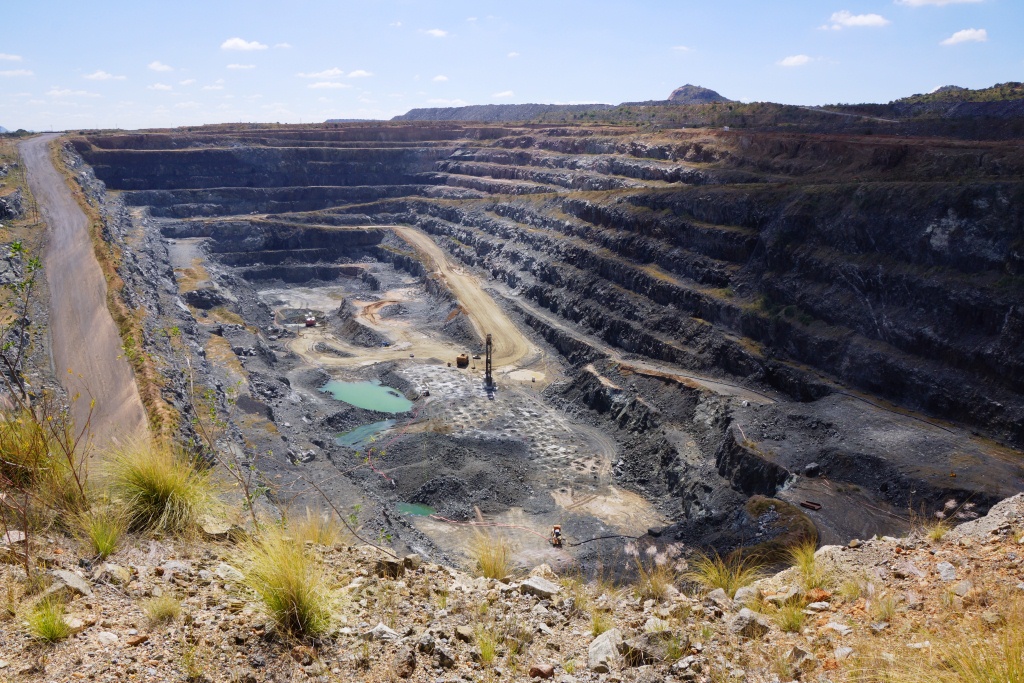
by Deep Green Resistance News Service | Aug 28, 2017 | Toxification
Peak oil extraction has passed and extraction will decline from this point onward. No industrial renewables are adequate substitutes. Richard C. Duncan sums it up in his “Olduvai Theory” of industrial civilization. Duncan predicted a gradual per capita energy decline between 1979 and 1999 (the “slope”) followed by a “slide” of energy production that “begins in 2000 with the escalating warfare in the Middle East” and that “marks the all-time peak of world oil production.” After that is the “cliff,” which “begins in 2012 when an epidemic of permanent blackouts spreads worldwide, i.e., first there are waves of brownouts and temporary blackouts, then finally the electric power networks themselves expire.”34 According to Duncan, 2030 marks the end of industrial civilization and a return to “global equilibrium”—namely, the Stone Age.
Natural gas is also near peak production. Other fossil fuels, such as tar sands and coal, are harder to access and offer a poor energy return. The ecological effects of extracting and processing those fuels (let alone the effects of burning them) would be disastrous even compared to petroleum’s abysmal record.
Will peak oil avert global warming? Probably not. It’s true that cheap oil has no adequate industrial substitute. However, the large use of coal predates petroleum. Even postcollapse, it’s possible that large amounts of coal, tar sands, and other dirty fossil fuels could be used.
Although peak oil is a crisis, its effects are mostly beneficial: reduced burning of fossil fuels, reduced production of garbage, and decreased consumption of disposable goods, reduced capacity for superpowers to project their power globally, a shift toward organic food growing methods, a necessity for stronger communities, and so on. The worst effects of peak oil will be secondary—caused not by peak oil, but by the response of those in power.
Suffering a shortage of fossil fuels? Start turning food into fuel or cutting down forests to digest them into synthetic petroleum. Economic collapse causing people to default on their mortgages? Fuel too expensive to run some machines? The capitalists will find a way to kill two birds with one stone and institute a system of debtors prisons that will double as forced labor camps. A large number of prisons in the US and around the world already make extensive use of barely paid prison laborers, after all. Mass slavery, gulags, and the like are common in preindustrial civilizations. You get the idea.
Featured image: Mogolokwena Platinum Mine, South Africa
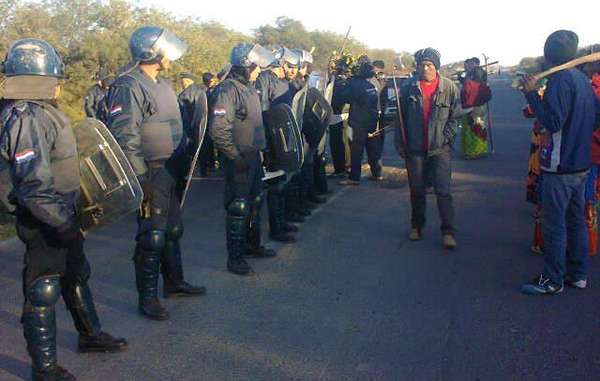
by Deep Green Resistance News Service | Aug 24, 2017 | Biodiversity & Habitat Destruction
Featured image: There have been confrontations between the Ayoreo and the Paraguayan authorities in recent years, as the tribe have protested against the theft and destruction of their land.© GAT/ Survival
by Survival International
Landmark talks between the Paraguayan government and a recently contacted tribe have yet to reach an agreement, allowing rampant deforestation to continue. Some members of the tribe are uncontacted, and live in a rapidly shrinking island of forest.
The talks began six months ago after a petition from the Ayoreo tribe to the Inter-American Commission on Human Rights, an influential body which holds governments in the Americas to account on human rights issues. The Ayoreo have been claiming the right to their ancestral land since 1993.
Halfway through the year-long process, however, and little concrete action has been taken, leading to fears for the tribe’s long-term survival. A technical study is due to be carried out to assess the feasibility of securing the land.
The government has also failed to stop the rapid logging of land owned by the Ayoreo, despite a 2016 emergency order from the Inter-American Commission to protect the uncontacted Indians and halt deforestation.
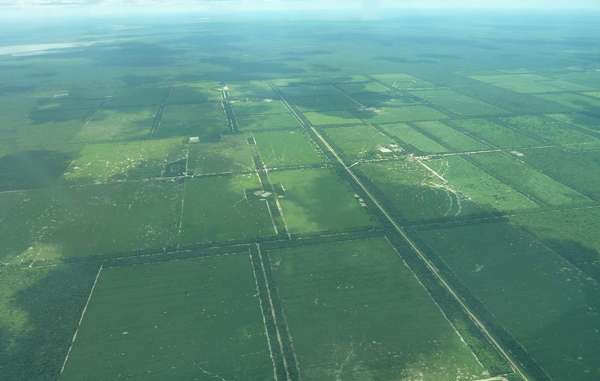
Aerial photograph showing the devastation that logging has brought to Ayoreo land. © Survival
Background briefing
– The Ayoreo live in the Chaco, which is the largest forest in South America outside the Amazon and has recently been recorded as having the highest rate of deforestation in the world. Experts estimate that the forest lost almost 10 million trees in January 2017.
– This poses a deadly threat to the Ayoreo, who face catastrophe unless their land is protected.
– Many members of the Ayoreo tribe were forcibly contacted by missionaries between 1969 and 1986. Continual land invasions forced them to abandon their homes. Many have since suffered from disease, including a TB-like illness, poverty, and exploitation on the fringes of mainstream Paraguayan society.
– Recently contacted members of the tribe spent years fleeing from bulldozers, which they called “beasts with metal skin.” The machines are used by loggers to clear paths for cutting trees.
– The petition which finally brought the Paraguayan government to the negotiating table is called Petition 850-15. It features a claim for the restitution of Ayoreo land.
– In February 2016, the Inter-American Commission issued an emergency order (MC 54-13) calling for the protection of uncontacted Ayoreo and their forests. Although this was in response to a separate petition submitted by the Ayoreo, the orders are to also be discussed during the talks.
– The local support group GAT, and indigenous organization OPIT, have played an important role in lobbying the government, and after months of warning, finally pressed them to investigate the logging in July 2017. It remains to be seen whether the deforestation will be stopped and the perpetrators brought to justice.
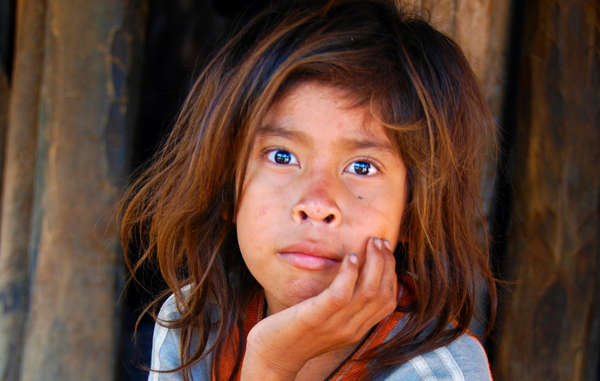
Most of the Ayoreo have been forced out of the forest. They have since been fighting for their land rights. © Survival
Survival International is calling for a complete halt to logging on Ayoreo land, and for the return of all lands which have been titled to ranching companies.
Uncontacted tribes are not backward and primitive relics of a remote past. They are our contemporaries and a vitally important part of humankind’s diversity. Where their rights are respected, they continue to thrive.
They are the best guardians of their environment. And evidence proves that tribal territories are the best barrier to deforestation.
Survival’s Director Stephen Corry said: “The Ayoreo have already been waiting more than twenty years for their lands to be protected. All this time they’ve seen their forests destroyed about them. They hoped the Inter-American Commission’s intervention would finally push the government to act, but that hope too has proved an illusion. Tragically, it seems that Paraguay’s government is so firmly tied to the ranchers and landowners who control the levers of power that nothing short of massive public pressure will move them to act.”










